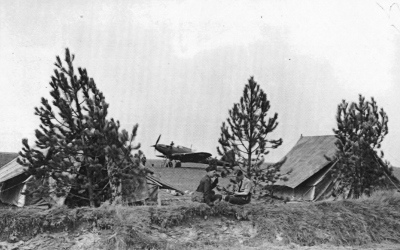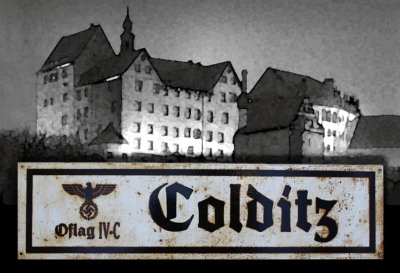Flight Lieutenant Howard Douglas “Hank” Wardle Military Cross.
Howard Wardle was born in Dauphin, Manitoba, Canada August 14th 1915. Pre-war Howard, or Hank as he was called, worked as a book keeper. With war looming Hank and two friends sailed for England to join the RAF, only Hank was successful. In March 1939, Hank was granted a Short Service Commission, after completing his training and gaining his wings, he was posted in November 1939 to No.98 (Bomber) Squadron based at RAF Hucknall operating the Fairey Battle. Hanks stay was short lived, on November 29th, he along with his observer, Sergeant Edward Davidson and air gunner, Aircraftman 1st Class Albert Bailey were posted to No.218 (Bomber) Squadron commanded by Wing Commander Duggan
Based at Auberive-sur-Suippes, France the squadron was part of No.75 Wing AASF. No.75 Wing was controlled by Group Captain A Wann from his HQ at St Hilaire le Grand and consisted of three squadrons of Fairey Battles, No.88, 103 and 218.Hanks first recorded flight in the Squadron Operational Records Book (ORB), is dated December 1st when he carried out a 55 minute flight in Battle K9326 to familiarise himself with the local area. The remainder of the month he carried out numerous training flights in worsening weather. The winter of 1940 was particular harsh and impacted on training, Hank had the opportunity to fly a number of training flights and bombing exercises during January, all without incident. Flying in February and March was equally mundane and in was not until April the tempo of flights increased.

A No.218 (Bomber) Squadron Fairey Battle at dispersal. The primitive conditions of Auberive are seen to good effect in this photograph.
Saturday April 20th 1940, No.218 Squadron was stand by squadron, half of its Battles were to be available if needed. During the morning, order No.7 arrived, the squadron was instructed to make ready four aircraft and crews, they would be required to carry out a reconnaissance of the Rhine and Nickle drop the German towns of Darmstadt and Mainz that night. The first section were aloft at 20:35hrs, F/O Newton in Battle L5235, was followed by Hank at 20:55hrs in Battle P2201. Fifty minutes later, the second section comprising of F/Lt Crews and Sgt Horner departed Auberive. Within twenty minutes, Sgt Horner was back over the airfield with WT failure. Flight Lieutenant Crews and F/O Newton both successfully completed their assigned operation, remarking upon their return that no AA was encountered but searchlight activity was intense along the whole of the Rhine. While over Germany the Merlin engine of Hanks Battle mysteriously and suddenly burst into flames, the ensuring fire resulted in Hank ordering the crew to bail out. Only Hank survived, his crew, observer, Sergeant Edward Davidson and air gunner, Aircraftman 1st Class Albert Bailey were killed. How both airman died is a mystery, either they bailed out too low or perhaps they were killed by enemy action.The report below records that Hank was capture near Crailsheim, this is approximately 80 miles south east of Darmstadt the most southerly target to be attacked. The mysterious engine fire was in all probability the result of the Battle being attacked by a Bf109 night-fighter. It is believed that Hank was shot down by Feldwebel Schmale of the 12th Staffel JG2 at 00;45hrs. This may explain why the two crew in the rear of the Battle were killed, perhaps injured or already dead, they crashed with the Battle. This encounter is reported to be the first instance of a British bomber being shot down over Germany at night. The following night, Hamburg radio broadcast that a machine was brought down over “Kreilsheim” and that P/O Wardle was a PoW. This was later confirmed by the Geneva Red Cross.

Taken in Colditz, a group of PoW’s including Hank Wardle. Hank is back row third from left. Sitting in front with pipe is Captain Pat Reid.
On leaving Switzerland Hank along with a group of other escapees were taken by the French underground across Vichy France to the Spanish border, crossing the Pyrenees Mountain range. Issued with a fake passport in the name of Raoul, 6ft tall Hank was now a hairdresser. Once across the border Hank was immediately arrested and placed in jail! Eventually he was released and taken to Gibraltar and flown back to the UK arriving February 5th 1944. What is remarkable is that Hank crossed the mountains with a injured leg, the result of a severe beating he had received when captured after his first escape attempt in 1940. While in Oflag IVc he often walked with the aid of a walking stick, he was also partially deaf in one ear, the result of a rifle butt. In 1944 he married June Porter and began ferrying bombers to the Middle and Far East. Hank was awarded the Military Cross – awarded as per London Gazette dated 16 May 1944. Towards the end of the war, Hank still ferrying bombers switched to flying bombers from Canada across the Atlantic to the United Kingdom. With the war ended, Hank remain in the air force, he was involved in a mid-air collision, which resulted in a crash in 1948, soon after he resigned his commission. Hank died 1995 in Ottawa, Canada, Below is a copy of Hanks Escape Report (Ref WO208/3311)
A copy of the Military Cross citation. By March 1944 No.218 Squadron was operating with No.3 Group RAF Bomber Command, hence the signature of Air Vice-Marshall Harrison, AOC No.3 Group.







